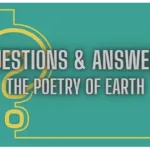The poetry of earth reflects the idea that nature’s beauty and harmony are eternal. This concept is particularly prominent in literature and poetry, focusing on the continuous presence of nature’s song. Through symbolism, poets like John Keats emphasize how nature thrives and continues despite changes in seasons or life.
The Poetry Of Earth Question Answers:
Question: What does “The Poetry of Earth” symbolize?
Answer: It symbolizes the continuous and eternal beauty of nature, unaffected by time or seasons.
Question: Who wrote the poem “On the Grasshopper and Cricket”?
Answer: John Keats wrote the poem.
Question: What is the central theme of “The Poetry of Earth”?
Answer: The central theme is the continuity of nature’s beauty and its persistence through all seasons.
Question: What role does the grasshopper play in Keats’ poem?
Answer: The grasshopper represents summer, symbolizing joy, liveliness, and abundance.
Question: How does the cricket contribute to the poem’s meaning?
Answer: The cricket symbolizes winter and the continuation of nature’s song in the stillness of the cold season.
Question: What literary device is primarily used to describe nature in the poem?
Answer: Personification is primarily used, attributing human-like qualities to nature.
Question: How does Keats depict the passage of time in the poem?
Answer: Keats shows that nature’s song continues from season to season, symbolizing the unchanging nature of earth’s beauty.
Question: What is the significance of the grasshopper’s song in summer?
Answer: The grasshopper’s song represents the vibrancy and joy of life during the warm season of summer.
Question: What does the cricket’s song signify in winter?
Answer: The cricket’s song signifies the persistence of nature’s melody, even in the quiet and cold of winter.
Question: How does Keats’ poem reflect Romantic ideals?
Answer: It reflects Romantic ideals by emphasizing nature’s beauty, its eternal presence, and its ability to inspire human emotions.
Question: What is the tone of “On the Grasshopper and Cricket”?
Answer: The tone is peaceful and reflective, celebrating the constancy of nature.
Question: How does Keats convey the idea of continuity in nature?
Answer: He uses the alternating presence of the grasshopper and cricket to illustrate how nature’s song never fades, even when seasons change.
Question: What is the connection between the grasshopper and cricket in the poem?
Answer: Both represent different seasons (summer and winter) but together show that nature’s song continues uninterrupted throughout the year.
Question: How does the poem describe the seasons of summer and winter?
Answer: Summer is depicted as lively and full of energy with the grasshopper, while winter is quieter but still vibrant with the cricket.
Question: What message does Keats convey about the permanence of nature?
Answer: Keats conveys that nature’s beauty and song are permanent, never ceasing despite seasonal or external changes.
Question: How does the poem use sound as a motif?
Answer: The sounds of the grasshopper and cricket serve as motifs for the continuous music of nature.
Question: How does the imagery of the poem create a sense of peace?
Answer: Keats uses imagery of calm, continuous natural sounds and scenes to evoke a sense of peace and tranquility.
Question: What type of poem is “On the Grasshopper and Cricket”?
Answer: It is a sonnet.
Question: What literary movement does Keats belong to?
Answer: Keats belongs to the Romantic literary movement.
Question: How is the theme of immortality presented in the poem?
Answer: The immortality of nature is presented through the endless cycle of seasons and the continuous presence of natural sounds.
Question: What is the significance of using the grasshopper and cricket as symbols?
Answer: They symbolize the unbroken rhythm of nature across different seasons.
Question: How does Keats personify nature in his poem?
Answer: He attributes human qualities like singing and joy to natural elements like the grasshopper and cricket.
Question: What emotions does the poem evoke in the reader?
Answer: The poem evokes feelings of peace, continuity, and appreciation for the beauty of nature.
Question: What contrasts are drawn between summer and winter in the poem?
Answer: Summer is portrayed as lively and bustling with the grasshopper, while winter is quiet and still, but the cricket ensures nature’s song continues.
Question: How does the poem emphasize the idea of resilience in nature?
Answer: The poem shows that nature’s song never stops, even in the harshest conditions like winter.
Question: Why is the poem considered a reflection of Romanticism?
Answer: It focuses on nature’s beauty, the eternal cycle of life, and evokes deep emotion, all central themes in Romanticism.
Question: What is the significance of the grasshopper “resting” beneath a pleasant weed?
Answer: It signifies the cycle of activity and rest in nature, as the grasshopper takes a break during the heat of summer.
Question: How does Keats present the concept of time in the poem?
Answer: Keats presents time as cyclical, with nature continuously transitioning between seasons without ever stopping.
Question: How does “On the Grasshopper and Cricket” contrast with traditional depictions of winter?
Answer: Traditional depictions of winter emphasize barrenness and silence, but Keats highlights how nature’s song continues with the cricket.
Question: What is the form of “On the Grasshopper and Cricket”?
Answer: The poem is written in the form of a Petrarchan sonnet.
Question: How does the poem reflect the idea that nature is a source of inspiration?
Answer: The continuous song of nature, represented by the grasshopper and cricket, serves as an eternal source of inspiration for humans.
Question: How does the poem capture the essence of the changing seasons?
Answer: Through the grasshopper and cricket, the poem captures the vibrancy of summer and the quiet persistence of winter.
Question: How does Keats’ use of language create a musical effect in the poem?
Answer: Keats uses rhythmic, flowing language to mimic the continuous song of nature.
Question: Why does the grasshopper symbolize the poetry of earth in summer?
Answer: The grasshopper’s active presence in the heat of summer represents the lively, thriving aspect of nature during this season.
Question: How does the cricket’s song differ from the grasshopper’s in the poem?
Answer: The cricket’s song is quieter, heard indoors by the warmth of a fire, contrasting the grasshopper’s lively, outdoor presence.
Question: How does Keats make the winter season seem less harsh?
Answer: By focusing on the cricket’s song, Keats shows that even in winter, there is warmth and life.
Question: What does Keats imply about human connection to nature in the poem?
Answer: Keats implies that humans are deeply connected to nature, finding solace and reflection in its unchanging presence.
Question: How does the poem suggest that nature’s beauty is timeless?
Answer: By showing that nature continues its song in both summer and winter, Keats suggests that beauty is ever-present and unending.
Question: What does the poem say about the importance of listening to nature?
Answer: The poem encourages an appreciation for nature’s quiet, continuous song, suggesting that beauty can be found in even the smallest sounds.
Question: How does Keats portray the relationship between life and nature in the poem?
Answer: Keats portrays life as intertwined with nature, with both following a continuous, harmonious cycle.
Question: How does Keats convey peace through the poem?
Answer: The consistent song of nature throughout the changing seasons evokes a sense of peace and continuity.
Question: What is the significance of the final line of the poem?
Answer: The final line emphasizes that the poetry of earth never dies, reaffirming the eternal presence of nature.
Question: How does the poem reflect Keats’ admiration for nature?
Answer: Keats’ detailed and loving descriptions of the grasshopper and cricket reflect his deep admiration for the natural world.
Question: What role do sensory details play in the poem?
Answer: Sensory details like sound and temperature bring the scenes of summer and winter to life, engaging the reader’s senses.
Question: How does the poem reflect the idea of nature as a refuge?
Answer: The poem suggests that nature provides a constant refuge, with its song continuing even in difficult times like winter.
Question: What is the structure of “On the Grasshopper and Cricket”?
Answer: The poem is divided into an octave and a sestet, typical of a Petrarchan sonnet.
Question: How does Keats use contrast in the poem?
Answer: Keats contrasts the lively summer with the quieter winter, showing how both seasons contribute to the eternal song of nature.
Question: What does Keats’ choice of animals (grasshopper and cricket) reveal about his view of nature?
Answer: Keats’ choice of small, unassuming creatures like the grasshopper and cricket reveals his belief that all parts of nature, no matter how small, contribute to its beauty.
Latest Posts
- Step-by-step guide to download and apply for jee mains admit card 202
- Comprehensive 2025 government holidays and recruitment details for job seekers
- JEE Mains Admit Card 2025: Your Step-by-Step Guide to Downloading the Hall Ticket
- Everything You Need to Know About 2025 Government Holidays Recruitment
- Comprehensive Guide to rrb d group recruitment 2025 – Eligibility, Vacancies, and Application
- Detailed guide to nps trust recruitment 2025 vacancies, eligibility and apply process
- Comprehensive guide to hpcl recruitment 2025 notification, vacancies, and application process
- ignou bed admission 2025 complete recruitment guide with eligibility and process
- Comprehensive Guide to Indian Army Agniveer Recruitment 2025 Notification and Jobs
- Everything You Must Know About CBSE Board Exams 2025 Changes & New Rules




